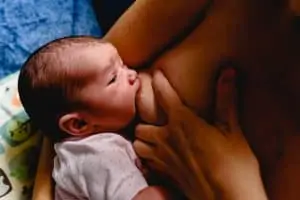When you start breastfeeding, you might be encouraged to switch breasts while nursing, but you need to be careful and do so correctly. For some babies, changing breasts is required, but many mothers note that their babies don’t require switching. It’s individual rather than static across the board.
For years, mothers were told to breastfeed for 10 minutes on one breast, and 10 minutes on the other breast. This is an outdated practice. We know that not all babies are finished nursing in 20 minutes, especially newborns who aren’t as efficient at draining the breast as a larger baby.
So, what are you supposed to do? Here’s what I did for the four babies that I breastfed.
Let Your Baby Finish The First Breast
If your baby is latched correctly and breastfeeding well, there is no need to switch breasts. It’s always best to let your baby completely finish the first breast before switching to the next.
Why?
You might not realize it, but breastmilk has different stages, and each is beneficial for your baby. When your baby first starts to breastfeed, foremilk comes out. It’s thinner milk that satisfies your baby’s initial hunger, but it’s not full of him up yet.
After the foremilk, your body gradually transitions to hindmilk, which is the fatty goodness that keeps your baby full and gives them the lovely rolls we love to squeeze.
Babies need both foremilk and hindmilk, but there isn’t an indicator on your breasts to tell you when the switch began. So, if you remove your baby too soon and put him on the next breast, that breast will start at foremilk. Your baby will totally miss out on the hindmilk!
Many babies are full after one breast, but it’s okay if not!
When Should You Offer the Second Breast
After you burp your baby, he will seem content, but your baby will still latch onto a breast if he’s still hungry. So, offer the second one. You’ll know that your baby might need more to eat if:
- He’s still rooting and looking for a breast.
- He starts to suck his fist.
- Your baby doesn’t seem content or fusses a lot.
- When offered, he latches and eats from the opposite breast.
- Your baby isn’t gaining properly or doesn’t have enough wet diapers.
In some situations, switching breasts during breastfeeding is recommended at each nursing session. A few of those situations include:
Your baby is sleepy at the breast all the time.
All new babies are sleepy, especially at the breast, but most tend to perk up as the days pass. If your baby is tired, switching breasts can be enough to wake him up more and to keep nursing.
This could be used at each nursing session if your baby is perpetually sleepy or situational and as needed.
You have a low breast milk supply.
If you know that you have a confirmed low breast milk supply, switching sides can boost it. You’re stimulating both sides with feeding, and your body gets the memo that you need to make more milk. How much milk you make is based on your supply and demand – the more you demand, the more your body supplies.
Relative: which foods help in increasing milk supply?
Your baby is gaining weight too slowly.
If your baby isn’t gaining enough weight, you should try to switch breasts during breastfeeding because it helps to increase how much breastmilk your baby takes in at each feeding. When you switch breasts, it encourages your baby to suck more to promote a letdown multiple times.
When You Shouldn’t Switch Sides
As mentioned initially, switching sides shouldn’t be used over an extended period unless you have a situation that calls for it. Once your supply is sufficient, your baby is alert and gaining appropriately; there is no reason to switch sides more than once a feeding.
While some babies need both sides due to their appetite, many are sufficient with just one breast. Watch your baby and his growth, along with his disposition, to decide what will work best.
In some situations, it’s not recommended to switch breasts during breastfeeding. Examples include:
- You have a premature baby.
- Your baby is sick or has an illness.
- You have a baby with a sucking issue or struggles to latch correctly.
Do Switch Which Breast You Start First

While switching breasts in the middle of feeding isn’t always necessary, you do need to alternate which breast you start first.
So, if you start nursing at noon on your left breast, when your baby is ready to eat at 2:30 PM, begin on your right one.
While it’s not necessarily wrong to start repeatedly on the same breast, it will cause engorgement on the opposite breast. It’s best to rotate to ensure that you don’t end up with a clogged duct that could lead to mastitis.
If you can’t remember, wear a bracelet on the wrist of the breast you started first. When you begin nursing, put the bracelet on that wrist, so you know to switch to the next side when you nurse the following time again.
Last Thoughts
It’s not always necessary to switch breasts while nursing. Many babies are content and full of one breast. Make sure you follow your baby’s individual needs rather than believing this suggestion works for all babies.
Hey, this is Linda. My biggest accomplishment in life is being a mother of four children. Their current ages range from almost ten years old down to 20 months old.
I’m passionate about writing parenting articles because I understand so well all of the problems and trials you face as a parent. From breastfeeding woes to budgeting problems and behavior problems, along with everything in between, chances are I’ve faced it over the last ten years. Read more about Linda here.






